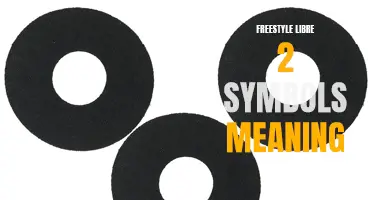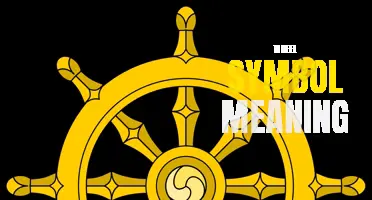
The use of symbols has been prevalent throughout human history, conveying deep meaning and serving as a visual representation of concepts and ideas. One such symbol that holds significant meaning is the shield. Shields have been used for protection in various cultures and time periods, but their symbolism goes beyond mere physical defense. These powerful emblems have come to represent concepts such as strength, resilience, courage, and even the quest for justice. Join me as we delve into the fascinating world of shield symbolism and uncover the multitude of meanings hidden within this iconic symbol.
What You'll Learn
- What is the meaning behind the shield symbol in different cultures?
- How has the shield symbol been used in heraldry throughout history?
- Do different colors or designs on a shield symbol have specific meanings?
- What is the significance of the shield symbol in mythology and folklore?
- How has the shield symbol evolved and been adapted in modern society, such as in logos or emblems?

What is the meaning behind the shield symbol in different cultures?
The shield symbol has been used by various cultures throughout history, and it often carries significant meaning. In different cultures, the shield symbolizes protection, strength, courage, and honor. Let's take a closer look at the meaning behind the shield symbol in different cultures.
In ancient Greek culture, the shield symbolized protection and was commonly used in battle. The most famous shield in Greek mythology is the Aegis, which was carried by the gods Zeus and Athena. The Aegis was said to have the power to protect its wearer from harm and repel enemies. A decorated shield was also seen as a symbol of courage and honor in Greek society.
Similarly, in Roman culture, the shield, known as a scutum, played a vital role in warfare. It was used to protect soldiers in battle and was often adorned with symbols and designs representing the legion to which the soldier belonged. The shield symbolized the bravery and strength of the Roman army and was a source of pride for the soldiers.
In Norse mythology and Viking culture, shields held great significance. They were not only used for protection but also as a means of displaying one's status and clan affiliation. Ornate designs and symbols were often carved into the shields, representing the warrior's ancestry, achievements, and connection to the gods. Shields were seen as a representation of a warrior's soul and were believed to possess magical qualities that could ward off evil spirits.
In Native American cultures, shields were used in ceremonial rituals and warfare. The shield symbolized protection and was believed to have spiritual powers. Native American shields were often adorned with symbols and animal motifs, representing the warrior's spirit guide or tribal affiliation. The designs and colors used on the shield were thought to have specific meanings and were chosen carefully to impart strength and courage.
In medieval Europe, shields were an essential part of knightly armor. They were often decorated with the knight's coat of arms, which represented their family and allegiance. Shields in this context symbolized honor, loyalty, and bravery in battle. The shield was an extension of the knight's identity, and losing one's shield in battle was seen as a great dishonor.
In modern times, the shield symbol continues to be used in various contexts. It is often associated with law enforcement agencies, representing protection and the upholding of justice. In corporate logos, the shield symbol may reflect strength, reliability, and security. It is also commonly used in sports team logos, signifying the team's defensive capabilities and unity.
In conclusion, the shield symbol holds great symbolism in different cultures. Whether representing protection, strength, courage, or honor, the shield has been a powerful and meaningful symbol throughout history. Its significance varies across cultures, but its underlying message of defense and resilience remains constant.
Decoding the Hidden Symbols on Tinder: What Do They Really Mean?
You may want to see also

How has the shield symbol been used in heraldry throughout history?
Throughout history, the shield symbol has played a significant role in heraldry. Heraldry, the practice of designing, displaying, and describing coats of arms and badges, has its roots in medieval Europe. Shields were commonly used as a canvas for displaying various symbols, colors, and patterns that represented the identity, status, and achievements of individuals, families, organizations, and even countries.
In medieval times, knights would often paint their shields with distinctive symbols or "charges" to distinguish themselves in battle. These charges could take the form of animals, plants, mythical creatures, or geometric patterns. The shield symbol functioned as a way to identify knights on the battlefield and also helped to foster a sense of pride and belonging.
As heraldry evolved, shields became more elaborate and complex. They began to incorporate multiple charges, called "quarterings," to symbolize different family alliances or accomplishments. For example, a knight who had married into a noble family might add the ancestral coat of arms to their shield, representing their new lineage.
The shield symbol was also used to denote social status and hierarchy. In many European countries, the design of a shield was strictly regulated and only certain individuals were allowed to display certain symbols. The shield of the king or queen, for example, would typically feature the royal arms and crown, while a nobleman's shield might incorporate symbols specific to his rank or position.
In addition to personal and family shields, the shield symbol was used to represent cities, provinces, and even countries. Municipalities would often incorporate a shield into their official seals or flags, displaying symbols that represented their history, geography, or local industries. This practice continues to this day, with many cities and regions around the world featuring shields in their official emblems.
The shield symbol also took on religious significance in heraldry. Knights who went on Crusades would often incorporate Christian symbols, such as the cross, into their shields to display their faith and commitment to their cause. Similarly, the shields of religious orders, such as the Knights Templar, would feature symbols associated with their order or patron saints.
Today, the shield symbol remains an important part of heraldry, although its use has changed over time. While it is still used to represent families, organizations, and regions, it is also utilized in logos, brand identities, and military insignia. The shield symbol has become synonymous with strength, protection, and tradition, making it a popular choice for companies and institutions looking to convey these qualities.
In conclusion, the shield symbol has been used in heraldry throughout history to represent identity, status, achievements, and affiliations. Whether painted on the shields of medieval knights or incorporated into the emblems of modern organizations, the shield continues to be a powerful and enduring symbol. Its rich history and association with strength and protection make it a timeless choice in heraldic design.
Exploring the Rich Symbolism and Meanings Behind Native American Pottery
You may want to see also

Do different colors or designs on a shield symbol have specific meanings?
Shields have a long-standing history as a symbol of protection and authority. Throughout various cultures and time periods, shields have been adorned with different colors and designs to convey specific meanings. These colors and designs can provide insight into the role or identity of the shield bearer.
In ancient times, shields were often decorated with distinct colors and patterns to represent different factions or groups. For example, in ancient Greece, shields were often adorned with specific designs and colors to distinguish soldiers from different city-states. These designs became important identity markers on the battlefield, helping soldiers quickly identify allies and foes.
Similarly, in medieval Europe, different colors and patterns on a shield denoted the noble family or knight to which the bearer belonged. These designs, known as heraldic devices, were used to identify individuals on the battlefield or in tournaments. Each noble family had its own unique coat of arms, which typically consisted of specific colors, symbols, and patterns. This allowed knights and their shields to be easily recognized and associated with their family or allegiances.
In addition to identifying allegiances, the colors and designs on a shield could also convey specific meanings or characteristics. For instance, a shield adorned with the image of a lion was often associated with bravery and courage. This symbolism was commonly used in medieval heraldry, where different animals and symbols were used to represent virtues or attributes. Furthermore, specific colors on a shield could also hold significance. For example, a shield colored red might represent strength and power, while a shield colored blue might symbolize loyalty and honor.
It is important to note that the meanings associated with colors and designs on shields can vary across different cultures and time periods. While certain symbols and colors may have similar meanings in various contexts, their interpretations can also differ depending on the specific tradition or civilization.
In conclusion, the colors and designs on a shield can indeed have specific meanings. They can be used to identify factions or individuals and convey certain characteristics or virtues. The use of colors and symbols on shields has played a significant role in the history of warfare and heraldry, providing a visual language through which people could express their identities, allegiances, and values.
Understanding the Meaning Behind FFA Emblem Symbols
You may want to see also

What is the significance of the shield symbol in mythology and folklore?
The shield symbol holds great significance in mythology and folklore across different cultures and time periods. It is often depicted as a powerful and protective instrument that can ward off evil and provide a safeguard for those who possess it. The shield symbolizes defense, heroism, and resilience, and it has been used as a motif in various legends and tales.
In ancient Greek mythology, for example, the shield played a prominent role in the story of Perseus. Perseus, a demi-god, embarked on a quest to slay the monstrous Medusa and was given a reflective shield by the goddess Athena. This shield enabled Perseus to gaze at Medusa's reflection instead of directly at her, as her gaze turned anyone who looked directly at her into stone. The shield became a vital tool in Perseus' triumph over Medusa and represented his ability to protect himself from danger.
Similarly, in Norse mythology, the shield held great importance. It was a customary practice for warriors to carry round wooden shields into battle. These shields not only provided physical protection but were also believed to possess magical properties. The shield symbolized protection and represented the warrior's willingness to defend their homeland and fellow warriors.
In Celtic folklore, the shield symbolized the duality of protection and vulnerability. It was often associated with various deities and heroes who relied on shields to stave off attacks from adversaries. The shield was believed to act as a barrier between the physical world and the spiritual realm, safeguarding individuals from malevolent forces. It served as a metaphor for the human struggle against adversity and reminded people to remain steadfast in the face of challenges.
The use of shields as protective symbols extends beyond mythology and folklore. It is a motif that can be found in various cultural traditions, historical events, and contemporary representations. For example, the emblem of a shield is often found on coats of arms, representing noble families and their commitment to protect and defend their lands. It is also frequently used in military and defense logos, symbolizing the strength, resilience, and protection provided by these institutions.
Furthermore, the shield symbol has found its way into popular culture, including books, movies, and video games. The shield-wielding heroes and superheroes in these mediums embody the idea of defense and protection, using their shields as a physical and metaphorical tool to shield themselves and others from harm.
In conclusion, the shield symbol holds immense significance in mythology and folklore. It represents defense, heroism, and resilience and acts as a powerful protective instrument. Whether it is through ancient Greek mythology, Norse folklore, or Celtic legends, the shield symbolizes the idea of protection and serves as a reminder to face adversity with courage and determination. Its enduring presence in various cultural traditions and popular culture reflects its universal appeal as a symbol of strength and defense.
Decoding the Symbolic Meaning Behind the Ecuador Flag
You may want to see also

How has the shield symbol evolved and been adapted in modern society, such as in logos or emblems?
The shield symbol has a long and rich history as a representation of protection, strength, and authority. It has been used throughout different cultures and time periods as a means to convey these concepts. In modern society, the shield symbol has continued to be adapted and evolved in various ways, particularly in logos and emblems.
One of the most notable examples of the shield symbol's adaptation in modern society can be seen in the logos of various law enforcement agencies. Police departments around the world often incorporate a shield into their logo design to symbolize the protection and security they provide to their communities. The shield shape, with its distinctive curved top and straight sides, has become synonymous with authority and law enforcement.
Similarly, the shield symbol has been adopted by various branches of the military as well. Many armed forces incorporate shields into their emblems and patches as a way to represent their protective role in defending their respective countries. The shield symbolizes not only physical protection but also the dedication and bravery required of those in the military.
In addition to its use in law enforcement and the military, the shield symbol has been adapted in corporate logos and branding. Companies that specialize in security services or products often use the shield symbol as a way to convey trust and reliability. The shield serves as a visual representation that their products or services will safeguard the customer's interests.
Furthermore, the shield symbol has found its place in sports team logos and emblems. Many sports teams, particularly those with names that convey strength, power, or protection, incorporate a shield into their branding. The shield serves as a visual representation of the team's strength and determination to defend and protect their honor on the field.
In recent years, the shield symbol has also been adapted in a more abstract and stylized manner in various modern logo designs. Designers often use simplified shield shapes or incorporate elements of a shield, such as overlapping lines or geometric patterns, to create a visually appealing and meaningful logo. These modern adaptations of the shield symbol often aim to convey a sense of protection, strength, and reliability, while also adding a contemporary and unique touch.
In conclusion, the shield symbol has evolved and been adapted in modern society in various ways, particularly in logos and emblems. From its prominent use in law enforcement and the military to its incorporation in corporate branding and sports team logos, the shield symbol continues to represent protection, strength, and authority. Its adaptability and timeless symbolism make it a popular choice for conveying these concepts in a visually impactful manner.
Deciphering the Symbolic Meaning Behind the Alfa Romeo Emblem
You may want to see also
Frequently asked questions
The shield symbol is often associated with protection and defense. It represents the idea of a barrier or barrier against harm or danger. In various cultures and contexts, the shield symbol can also symbolize courage, strength, and resilience.
The use of shields as symbols dates back to ancient times. Shields were commonly used as a means of protection in warfare, and their symbols or designs would often have personal or cultural significance. The symbols on shields would often represent a specific family, tribe, or group, identifying them in battle.
Some common shield symbols include lions, eagles, crosses, crowns, and various geometric patterns. These symbols can vary in meaning depending on the specific culture or context in which they are used. For example, a lion on a shield might symbolize strength and bravery, while a cross on a shield could represent religious faith or protection.
Absolutely! While the use of shields in warfare may not be as prevalent today, the shield symbol can still be used to convey concepts such as protection, defense, and strength. It is often seen in logos or emblems representing organizations or companies that prioritize security or safeguarding their clients or customers.
Yes, the shield is a central element in heraldry, the system of visual identification used by knights and nobles during medieval times. In heraldry, different colors, shapes, and symbols depicted on the shield would convey specific meanings or messages about the individual or family. The shield symbol in heraldry is often associated with nobility, lineage, and honor.







